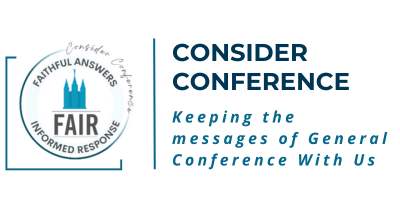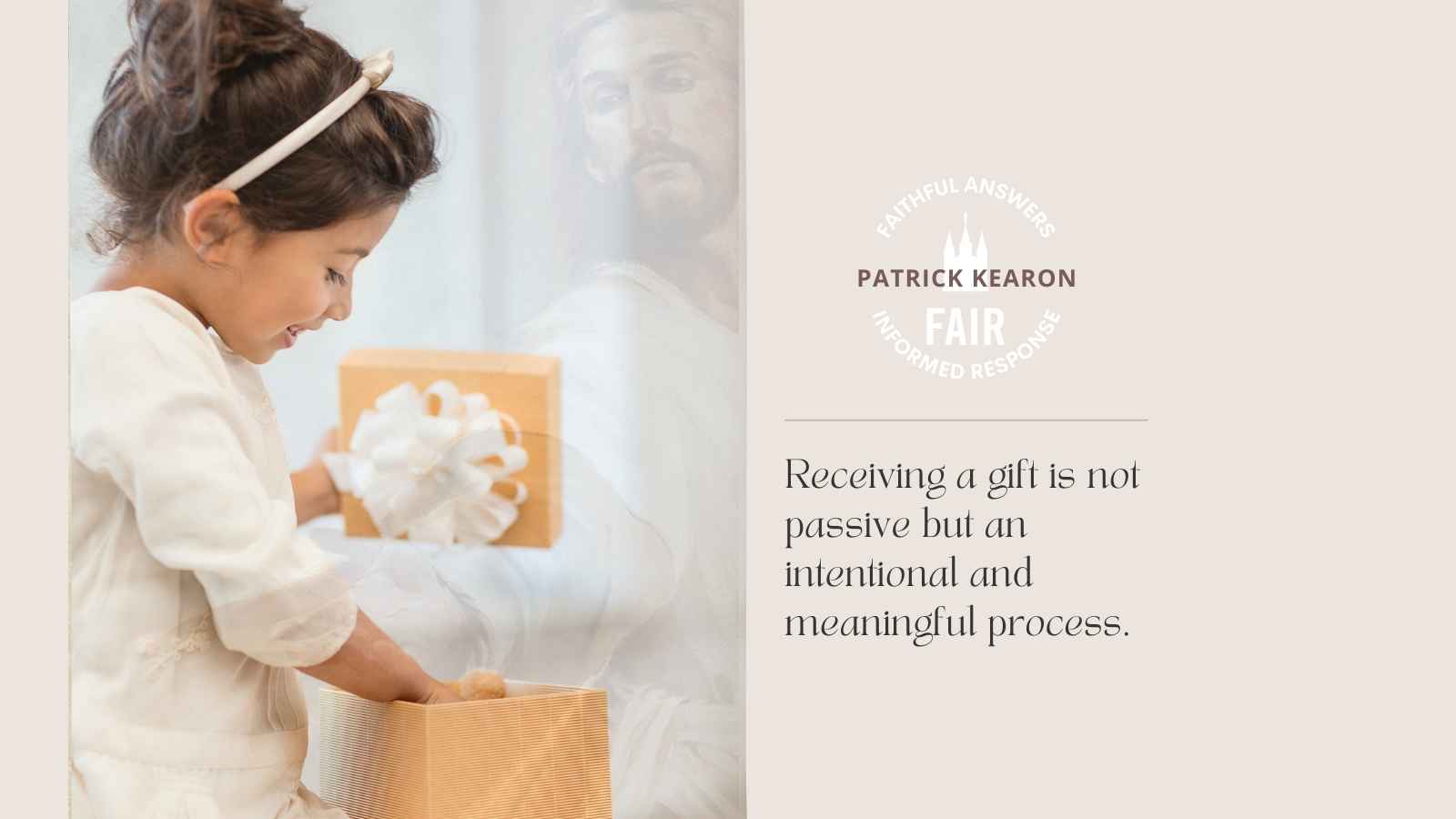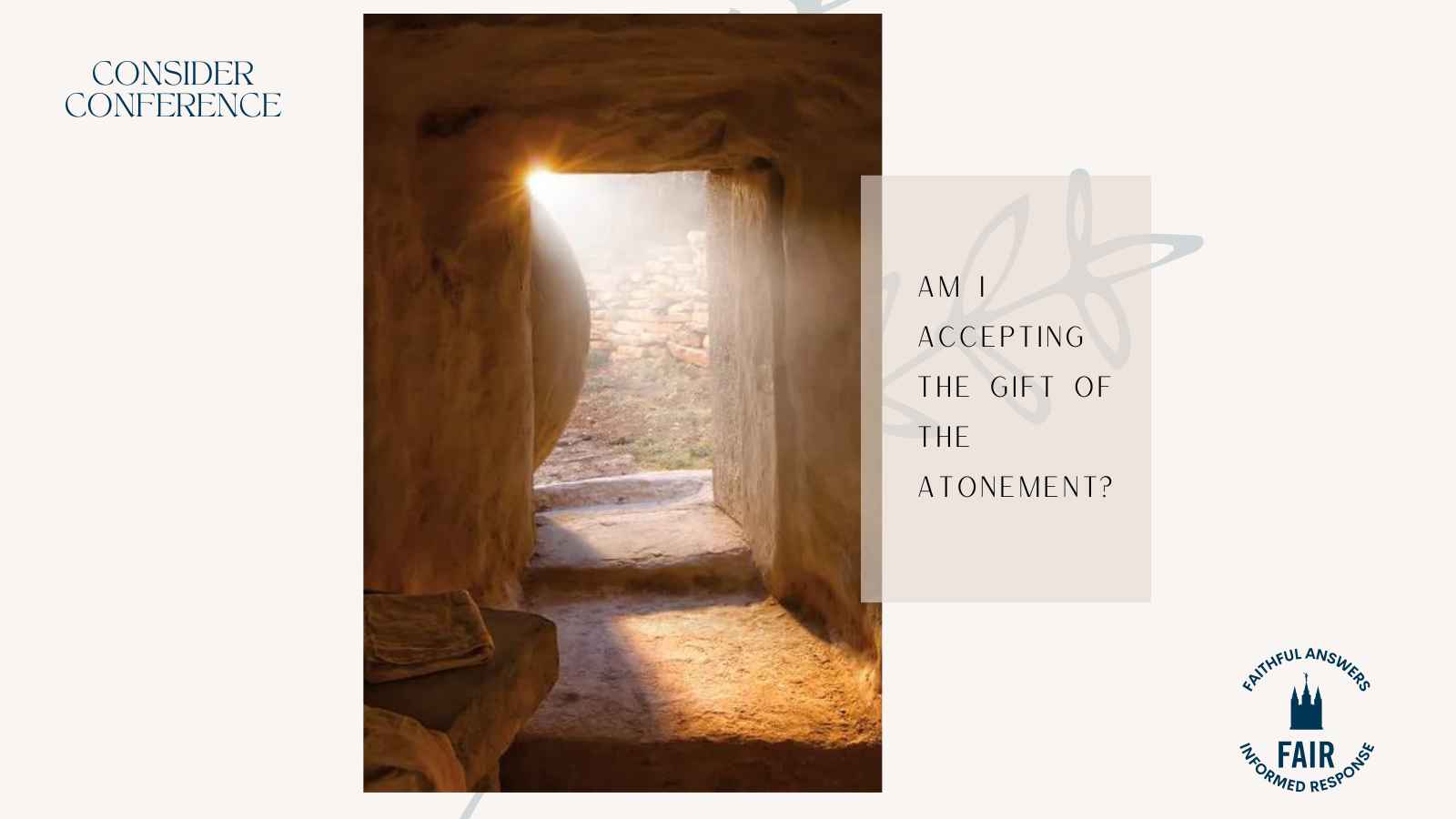Did you know that FAIR has Easter Resources? Find them here.

Anchoring our Identity and Eternity in Jesus Christ
What does it really mean to receive a gift—not just open it, but internalize it, live it, and let it define your very identity?
In his deeply moving General Conference message, “Receive His Gift,” Elder Patrick Kearon invites us to pause and reflect on the most profound of all gifts: the perfect, holy Son of God, sent by our Heavenly Father for us. Elder Kearon explores what it means to truly receive this divine gift—not passively, but intentionally—and how embracing this gift reframes our identity as children of God and anchors us in the realities of Christ’s atonement and resurrection.
As we prepare to celebrate Easter and study Doctrine and Covenants 110, where the risen Lord declared, “I am he who liveth, I am he who was slain,” Elder Kearon’s message is a powerful reminder that Christ not only suffered and died for us—He lives. His resurrection is not symbolic. It is literal, physical, and eternal, and it is the foundation upon which all other gifts from God rest.
Will we open that gift?
Will we let it change us?
This Easter, Elder Kearon’s words ask us to do just that.

 Apologetic Issues: Atonement and the Literal Resurrection
Apologetic Issues: Atonement and the Literal Resurrection
Criticism: The Atonement doesn’t make sense—why would a loving God require His Son to suffer and die in order to forgive?
Response: The Atonement is not an arbitrary requirement; it is the only way to reconcile fallen humanity with eternal life and joy.
Elder Kearon reminds us that Jesus Christ is “the supreme gift from our Father of Lights”—a willing offering made out of divine love, not coerced duty. The Atonement was not about satisfying a wrathful God, but about redeeming and sanctifying His children through mercy, justice, and covenant. In Doctrine and Covenants 19:16–19, the Savior says, “Glory be to the Father, and I partook and finished my preparations.” He chose this path.
Solution: The Atonement should be understood as the voluntary gift of the Son, offered in unity with the Father, to make it possible for us to be healed, redeemed, and transformed through divine grace.
 Common Fallacy: Straw Man
Common Fallacy: Straw Man
This misconception builds a Straw Man Fallacy by oversimplifying and distorting the doctrine of the Atonement to make it easier to reject. It ignores the volition, divine purpose, and eternal love that define the Savior’s sacrifice.
Criticism: The Resurrection of Jesus is a metaphor, not a literal event. Belief in a physical resurrection is unscientific, unnecessary, or symbolic at best.
Response: The empty tomb was not metaphorical—it was the turning point of all human history.
Elder Kearon speaks directly to the reality and power of Christ’s resurrection when he says, “Jesus Christ, our merciful Redeemer, is the supreme gift from our Father of lights.” Without the literal resurrection, the gift of eternal life could not be fulfilled. Doctrine and Covenants 88:14–17 teaches that spirit and body are the soul of man, and their eternal reuniting is central to God’s plan.
Solution: Rather than denying miracles because they are uncommon, we can seek evidence and personal spiritual confirmation. Historical and eyewitness testimonies—like those recorded in Doctrine and Covenants 76:22–24—reinforce that Christ’s resurrection was literal and visible, not merely poetic.
 Common Fallacy: Appeal to Modernity
Common Fallacy: Appeal to Modernity
Dismissing the Resurrection as unscientific relies on the Appeal to Modernity Fallacy—the idea that newer thinking must be superior to older belief. But truth is not determined by novelty.

 Apologetic Application: The Atonement of Jesus Christ
Apologetic Application: The Atonement of Jesus Christ
 Core Doctrine
Core Doctrine
The Atonement of Jesus Christ is the foundational doctrine through which all of God’s gifts—including resurrection, forgiveness, sanctification, and eternal life—are made possible. Elder Kearon declares, “All of our Father’s gifts flow from and are activated by the Saviour’s willing offering in Gethsemane and on the cross and His triumphant Resurrection.”
 Scriptures: Doctrine and Covenants 19:16–19, 2 Nephi 2:8
Scriptures: Doctrine and Covenants 19:16–19, 2 Nephi 2:8
Defending Core Beliefs
1⃣ Common Criticism:
The Atonement seems like an outdated or symbolic theological construct.
 Clarification: The Atonement is not metaphor—it is a literal, voluntary, and infinite act of love. Elder Kearon reinforces this by showing how deeply personal the Savior’s gift is. The Atonement is not merely an abstract transaction; it is the real offering of a living Savior, rooted in both history and eternity. It is the means by which we become sanctified and return to our Father.
Clarification: The Atonement is not metaphor—it is a literal, voluntary, and infinite act of love. Elder Kearon reinforces this by showing how deeply personal the Savior’s gift is. The Atonement is not merely an abstract transaction; it is the real offering of a living Savior, rooted in both history and eternity. It is the means by which we become sanctified and return to our Father.
2⃣ Follow-Up Criticism:
If salvation is a gift, why do I have to do anything to receive it?
 Clarification: Elder Kearon explains that “receiving a gift is not passive but an intentional and meaningful process.” Accepting the Atonement requires faith, humility, and covenant commitment—not as a way to earn salvation, but as a way to honor and fully receive it. The process of discipleship helps us internalize the Atonement’s power.
Clarification: Elder Kearon explains that “receiving a gift is not passive but an intentional and meaningful process.” Accepting the Atonement requires faith, humility, and covenant commitment—not as a way to earn salvation, but as a way to honor and fully receive it. The process of discipleship helps us internalize the Atonement’s power.
Practical Apologetic Use
When someone struggles to understand why bad things happen to good people, the doctrine of the Atonement allows us to say: “God is not absent. He has entered into suffering with us. He has felt every pain you’ve felt—and through Christ, offers healing, hope, and resurrection.”
It offers a way to approach grief, injustice, and doubt with eternal context and divine empathy.
 Historical and Doctrinal Connections
Historical and Doctrinal Connections
On Easter Sunday, April 3, 1836—less than a week after the dedication of the Kirtland Temple—the resurrected Jesus Christ appeared to Joseph Smith and Oliver Cowdery. His words were clear and eternal: “I am he who liveth, I am he who was slain” (Doctrine and Covenants 110:4). This event didn’t just confirm the Savior’s victory over death; it emphasized His ongoing, living role in directing His Church in the latter days.
Elder Kearon’s message echoes this profound reality: Jesus Christ lives now. The gift we are invited to receive isn’t distant or abstract—it’s immediate, personal, and transformative.
 Living Apologetics: Receiving—and Reflecting—the Gift
Living Apologetics: Receiving—and Reflecting—the Gift
 How do we help others understand that the Atonement is not symbolic or abstract—but real, personal, and transformative?
How do we help others understand that the Atonement is not symbolic or abstract—but real, personal, and transformative?
 Key Principle:
Key Principle:
Receiving the Atonement of Jesus Christ is an active process that reshapes our identity, relationships, and view of eternity. To truly receive Christ’s gift, we must let it sink deep into our soul—not just as doctrine, but as identity.
1⃣ Correct Misconceptions About Worthiness and Receiving God’s Love
Many people feel unworthy of divine gifts. You can respond with this truth from Elder Kearon:
“You are His child. You are beloved of Him. Do not complicate it.” Use that statement to counter false ideas that we must “earn” Christ’s love or prove our value.
2⃣ Clarify That the Resurrection Is Literal and Hope-Filled
Many see resurrection as wishful thinking or a metaphor. When discussing Easter, confidently state: “Because He lives, so will we. Our loved ones will rise again with perfect, immortal bodies.”
Faith in Action: Share the Message
 1. In a personal conversation – When someone expresses hopelessness, share Elder Kearon’s message that “you are a beloved daughter of God, you are a cherished son of God.”
1. In a personal conversation – When someone expresses hopelessness, share Elder Kearon’s message that “you are a beloved daughter of God, you are a cherished son of God.”
 2. In a Sunday or seminary lesson – Use the three parts of receiving a gift (giving, accepting/opening, receiving) as a powerful object lesson on the Atonement.
2. In a Sunday or seminary lesson – Use the three parts of receiving a gift (giving, accepting/opening, receiving) as a powerful object lesson on the Atonement.
 3. On social media or in a text message – Share the quote: “Come unto Christ, and lay hold upon every good gift.” (Moroni 10:30) and explain how you’ve received peace through Christ.
3. On social media or in a text message – Share the quote: “Come unto Christ, and lay hold upon every good gift.” (Moroni 10:30) and explain how you’ve received peace through Christ.
Quick Reference: Key Defenses and Facts
 The Atonement is a voluntary gift, not an extracted payment.
The Atonement is a voluntary gift, not an extracted payment.
Elder Kearon emphasizes that Jesus willingly offered Himself out of love, not obligation (see D&C 19:16–19). This corrects the misconception of a cruel transaction between Father and Son.
 Resurrection is a literal, physical promise—not a metaphor.
Resurrection is a literal, physical promise—not a metaphor.
Scriptures like D&C 88:14–17 teach that the soul is the body and spirit joined together—a doctrine reaffirmed by Christ’s Easter declaration in D&C 110:4: “I am he who liveth.”
 Receiving divine gifts is an intentional, active process.
Receiving divine gifts is an intentional, active process.
Elder Kearon teaches that to truly receive God’s gift, we must internalize it, live it, and let it reshape our identity, not merely acknowledge it. This clarifies the false idea that grace is passive.
Conclusion: Receiving Easter’s Greatest Gift
Elder Patrick Kearon’s message is a powerful reminder that the Atonement and Resurrection of Jesus Christ are not distant doctrines, but personal, present, and transformative gifts from a loving Father. This Easter, we’re invited not just to believe in Christ, but to receive Him—to let His redeeming power define who we are, shape how we see others, and anchor our hope beyond the grave.
Understanding and living this truth equips us not only to strengthen our own faith but to defend it with clarity and compassion. The Atonement is not symbolic. The Resurrection is not a metaphor. These are the very real gifts through which God invites us back to Him.
 So, as we remember the empty tomb and the Living Christ, may we ask ourselves:
So, as we remember the empty tomb and the Living Christ, may we ask ourselves:
Am I accepting the Gift of the Atonement?

Final Quote:
“You can come to Christ with confidence in His loving-kindness and receive all His gifts of joy, peace, hope, light, truth, revelation, knowledge, and wisdom—with your head held high, your arms outstretched, and your hands open, ready to receive. And you can receive these gifts because you are secure and grounded in the knowledge that you are a beloved daughter of God, you are a cherished son of God, and He has gifted you His perfect, holy Son to redeem you, justify you, and sanctify you.” —Elder Patrick Kearon
The Consider Conference series by FAIR offers an in-depth look at recent General Conference talks to help members of the Church of Jesus Christ of Latter-day Saints navigate common questions, misunderstandings, and criticisms. Each post provides doctrinal insights, historical context, and practical ways to apply gospel principles in everyday conversations. Through this series, we hope to equip readers with faith-promoting resources that encourage thoughtful reflection, respectful dialogue, and a stronger foundation in gospel truths, fostering both personal conviction and meaningful discussions with others.
The post Receive His Gift: Accepting the Atonement and the Reality of the Risen Christ appeared first on FAIR.
Continue reading at the original source →



